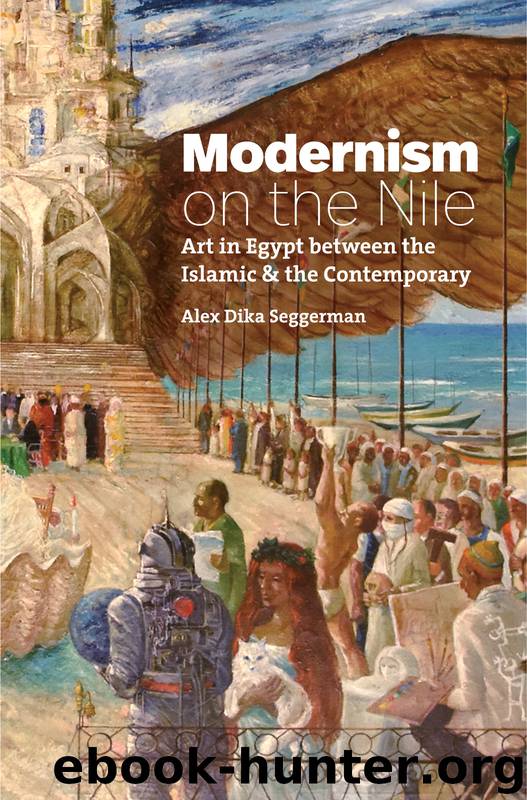Modernism on the Nile by Seggerman Alex Dika;

Author:Seggerman, Alex Dika;
Language: eng
Format: epub
Publisher: University of North Carolina Press
Published: 2019-10-17T16:00:00+00:00
Figure 3.13. Mahmoud Said, untitled sketch, n.d., ink on paper, collection of Dr. Hussam Rashwan, Alexandria, Egypt. Image reproduced courtesy of Dr. Hussam Rashwan, artwork reproduced courtesy of Samiha Lamerson and Saad Elkhadem.
In “Morning Sea,” Cavafy describes the brilliant blue of both sea and sky, and it is true that the sea and sky of Alexandria are stupendous, especially on a cloudless day, when the water appears almost electric. Said also noticed these colors. Marsa Matrouh (plate 11) paints Cavafy’s words—the sea and sky are a deep azure blue and the sand is a bright banana yellow. Said did not temper these hues with any tertiary colors; he painted them in scorching primary colors, possibly straight from the paint tube. While he clearly observed this scene while traveling to Marsa Matruh, a seaside town about 180 miles west of Alexandria, the colors defy reality. Likewise, in his poem, Cavafy confuses fantasy with observed reality. Rather than seeing reality, his memories and fantasies appear before him. This aspect also eerily parallels Said’s canvases: they represent observations but are simultaneously complete fantasies.
Recognized as one of the greatest poets in the Greek language since antiquity, Cavafy was born to a cosmopolitan Greek family in Alexandria in the mid-nineteenth century. He was recognized during his lifetime, though he never published a book.29 Instead, he printed his poems in newspapers or on broadsides circulated to a select group in Alexandria. While he was a generation older than Said, the two surely knew of each other, especially since Said’s roommate at his garçonnière was a Greek painter from Cavafy’s community. They were part of the same cosmopolitan community for which Alexandria’s coastline and port represented a lifeline to the transnational circulation of people, ideas, writings, and images of the late nineteenth and early twentieth centuries. Both Said’s landscapes and Cavafy’s poem reflect at once the desire to turn their observed reality of the land into truth through description and the final impossibility of achieving this.
In the last line of “Morning Sea,” Cavafy’s narrator claims he can only see “ikons of pleasure.” The original Greek used in this line is “ινδάλματα,” which carries many, nuanced meanings. Indeed, the various English translations of this poem do not agree, rendering ινδάλματα alternately as “images,” “idols,” and “hallucinations.” More specifically, the Greek term refers to mental images rather than seen images, and it plays off the “φαντασίες” (fantasies/daydreams) at the end of the previous line. In this poem, Cavafy highlights the divide between what is actually seen and what the mind sees, the narrator distraught at his inability to truly see reality. This simple act of describing the sea as blue and the sand as yellow turns them into “ikons”—mental images of pleasure that fool the eye. The poem laments that the act of description, whether visual or textual, can never be true reality.
Download
This site does not store any files on its server. We only index and link to content provided by other sites. Please contact the content providers to delete copyright contents if any and email us, we'll remove relevant links or contents immediately.
The History of Jihad: From Muhammad to ISIS by Spencer Robert(2508)
Nine Parts of Desire by Geraldine Brooks(2283)
The Turkish Psychedelic Explosion by Daniel Spicer(2247)
The First Muslim The Story of Muhammad by Lesley Hazleton(2159)
The Essential Rumi by Coleman Barks(1932)
1453 by Roger Crowley(1881)
The Last Mughal by William Dalrymple(1796)
Trickster Travels: A Sixteenth-Century Muslim Between Worlds by Davis Natalie Zemon(1785)
Muhammad: His Life Based on the Earliest Sources by Martin Lings(1569)
God by Aslan Reza(1564)
by Christianity & Islam(1564)
A Concise History of Sunnis and Shi'is by John McHugo(1518)
Magic and Divination in Early Islam by Emilie Savage-Smith;(1460)
No God But God by Reza Aslan(1438)
The Flight of the Intellectuals by Berman Paul(1401)
Art of Betrayal by Gordon Corera(1367)
Nothing to Envy by Barbara Demick(1328)
What the Qur'an Meant by Garry Wills(1325)
Getting Jesus Right: How Muslims Get Jesus and Islam Wrong by James A Beverley & Craig A Evans(1278)
